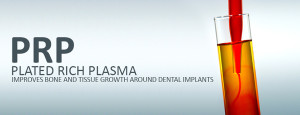After surgeries, it takes time for tissues and bones to regenerate. However, with PRP, or platelet-rich-plasma, patients are able to promote healing in various procedures. PRP treatments for dental implants can help to accelerate bone and tissue growth as well as heal wounds helping to guarantee long term success after various surgeries.
From NFL players to dental patients, PRP therapy is showing strong potential to aid in the healing process. Dental implant surgery patients can certainly benefit from this platelet-rich-plasma therapy treatment. Platelets, found naturally in blood, are removed, focused and applied to the wound to aid in the clotting and healing process.
 How to get Platelets?
How to get Platelets?
Since platelets are already found in blood, it is simple to extract and create this plasma. Platelets are part of the blood that respond at a wound site. They are responsible for clotting around the site, which helps prevent bleeding. Platelets are rich in healing and growth factors so they are often used with tissue healing all over the body.
So how do we extract platelets and plasma? Blood is drawn from a patient, which contains both plasma and platelets, and then put through a centrifuge, which separates the particles in the blood by density. The blood is then filtered to create the platelet rich plasma. Doctors use the plasma that is rich in platelets because it contains growth factor that increases healing.
What is PRP used for?
PRP is an extremely valuable adjunct to promote healing in surgical procedures. It can be particularly helpful when working with dental or oral surgeries, because healing time is essential to keep bacteria out of the bloodstream.
PRP treatments can help reduce bleeding and enhance soft tissue healing as well as bone regeneration. This can be especially helpful in cases with aging and older patients. From tooth extractions to periodontal surgery and implant surgery, the use of PRP helps to enhance wound healing and bone maturation.
What Does This Mean for Dentists & Dental Implants?
Because PRP treatments are already widely used in other medical fields such as cardiovascular surgery and maxillofacial surgery, it seems obvious that it would be beneficial with dental and oral surgery.
However, as with any medical procedure, there must be many trials to properly evaluate its effectiveness. Dentists have been reaching for this goal for a while and are finally able to implement the treatments on a wider scale. This can lead to quicker healing times, less discomfort and higher overall patient satisfaction.
Max is a marketing assistant for Southern Dental, a family practice, located in Marrero, Louisiana.

